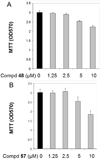Novel triaryl sulfonamide derivatives as selective cannabinoid receptor 2 inverse agonists and osteoclast inhibitors: discovery, optimization, and biological evaluation
- PMID: 23406429
- PMCID: PMC3967766
- DOI: 10.1021/jm3017464
Novel triaryl sulfonamide derivatives as selective cannabinoid receptor 2 inverse agonists and osteoclast inhibitors: discovery, optimization, and biological evaluation
Abstract
Cannabinoid receptors have gained increasing attention as drug targets for developing potential therapeutic ligands. Here, we report the discovery and optimization of triaryl sulfonamides as a novel series possessing significant CB2 receptor affinity and selectivity. Four sets of triaryl ligands were designed and synthesized for further structural modifications and led to the identification of eight compounds as potent and selective CB2 inverse agonists with high binding affinity (CB2K(i) < 10 nM). Especially, compound 57 exhibited the strongest binding affinity on the CB2 receptor (CB2K(i) of 0.5 nM) and the best selectivity over the CB1 receptor (selectivity index of 2594). Importantly, 57 also showed potent inhibitory activity on osteoclast formation, and it was confirmed by a cell viability assay that the inhibition effects were not derived from the cytotoxicity. Finally, 3D QSAR studies confirmed our SAR findings that three bulky groups play an important role for CB2 receptor binding affinity.
Figures










Similar articles
-
The tamoxifen derivative ridaifen-B is a high affinity selective CB2 receptor inverse agonist exhibiting anti-inflammatory and anti-osteoclastogenic effects.Toxicol Appl Pharmacol. 2018 Aug 15;353:31-42. doi: 10.1016/j.taap.2018.06.009. Epub 2018 Jun 12. Toxicol Appl Pharmacol. 2018. PMID: 29906493 Free PMC article.
-
Lead discovery, chemistry optimization, and biological evaluation studies of novel biamide derivatives as CB2 receptor inverse agonists and osteoclast inhibitors.J Med Chem. 2012 Nov 26;55(22):9973-87. doi: 10.1021/jm301212u. Epub 2012 Oct 31. J Med Chem. 2012. PMID: 23072339 Free PMC article.
-
Latest progress in the identification of novel synthetic ligands for the cannabinoid CB2 receptor.Mini Rev Med Chem. 2014 May;14(5):426-43. doi: 10.2174/1389557514666140428105753. Mini Rev Med Chem. 2014. PMID: 24766386 Review.
-
7-Oxo-[1,4]oxazino[2,3,4-ij]quinoline-6-carboxamides as selective CB(2) cannabinoid receptor ligands: structural investigations around a novel class of full agonists.J Med Chem. 2012 Jul 26;55(14):6608-23. doi: 10.1021/jm300763w. Epub 2012 Jul 11. J Med Chem. 2012. PMID: 22738271
-
Cannabinoid CB1 and CB2 receptor ligand specificity and the development of CB2-selective agonists.Curr Med Chem. 2008;15(14):1428-43. doi: 10.2174/092986708784567716. Curr Med Chem. 2008. PMID: 18537620 Review.
Cited by
-
Discovery of novel INK4C small-molecule inhibitors to promote human and murine hematopoietic stem cell ex vivo expansion.Sci Rep. 2015 Dec 18;5:18115. doi: 10.1038/srep18115. Sci Rep. 2015. PMID: 26681454 Free PMC article.
-
Multi-Functional Diarylurea Small Molecule Inhibitors of TRPV1 with Therapeutic Potential for Neuroinflammation.AAPS J. 2016 Jul;18(4):898-913. doi: 10.1208/s12248-016-9888-z. Epub 2016 Mar 21. AAPS J. 2016. PMID: 27000851 Free PMC article.
-
Xie2-64, a novel CB2 receptor inverse agonist, reduces cocaine abuse-related behaviors in rodents.Neuropharmacology. 2020 Oct 1;176:108241. doi: 10.1016/j.neuropharm.2020.108241. Epub 2020 Jul 24. Neuropharmacology. 2020. PMID: 32712273 Free PMC article.
-
Targeted inhibition of the type 2 cannabinoid receptor is a novel approach to reduce renal fibrosis.Kidney Int. 2018 Oct;94(4):756-772. doi: 10.1016/j.kint.2018.05.023. Epub 2018 Aug 6. Kidney Int. 2018. PMID: 30093080 Free PMC article.
-
Modeling, molecular dynamics simulation, and mutation validation for structure of cannabinoid receptor 2 based on known crystal structures of GPCRs.J Chem Inf Model. 2014 Sep 22;54(9):2483-99. doi: 10.1021/ci5002718. Epub 2014 Sep 5. J Chem Inf Model. 2014. PMID: 25141027 Free PMC article.
References
-
- Devane WA, Hanus L, Breuer A, Pertwee RG, Stevenson LA, Griffin G, Gibson D, Mandelbaum A, Etinger A, Mechoulam R. Isolation and structure of a brain constituent that binds to the cannabinoid receptor. Science. 1992;258:1946–1949. - PubMed
-
- Mechoulam R, Ben-Shabat S, Hanus L, Ligumsky M, Kaminski NE, Schatz AR, Gopher A, Almog S, Martin BR, Compton DR, et al. Identification of an endogenous 2-monoglyceride, present in canine gut, that binds to cannabinoid receptors. Biochem. Pharmacol. 1995;50:83–90. - PubMed
-
- Sugiura T, Kondo S, Sukagawa A, Nakane S, Shinoda A, Itoh K, Yamashita A, Waku K. 2-Arachidonoylglycerol: a possible endogenous cannabinoid receptor ligand in brain. Biochem. Biophys. Res. Commun. 1995;215:89–97. - PubMed
-
- Bayewitch M, Rhee MH, Avidor-Reiss T, Breuer A, Mechoulam R, Vogel Z. (−)-Delta9-tetrahydrocannabinol antagonizes the peripheral cannabinoid receptor-mediated inhibition of adenylyl cyclase. J. Biol. Chem. 1996;271:9902–9905. - PubMed
-
- Felder CC, Joyce KE, Briley EM, Mansouri J, Mackie K, Blond O, Lai Y, Ma AL, Mitchell RL. Comparison of the pharmacology and signal transduction of the human cannabinoid CB1 and CB2 receptors. Mol. Pharmacol. 1995;48:443–450. - PubMed
Publication types
MeSH terms
Substances
Grants and funding
LinkOut - more resources
Full Text Sources
Other Literature Sources
Chemical Information
Miscellaneous

